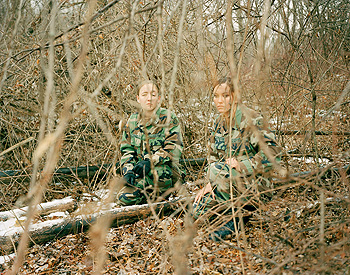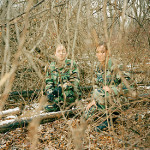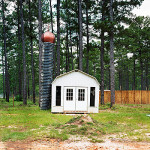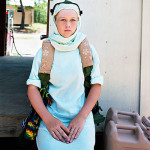Claire Beckett is a photographer based in the new England area and is a recent recipient of Massachusetts Cultural Artist Grant, and was a finalist in Photo Lucida's Critical Mass in 2007. For two years, Beckett worked as a Peace Corp Volunteer in the Republic of Benin, and in 2004, earned an MFA from the Massachusetts College of Art. Beckett's work has recently been shown at Bernard Toale Gallery and the University of Rhode Island.
Jess T. Dugan: Let's start by talking about your current work, In Training and Simulating Iraq. What drew you to this subject?
Claire Beckett: I am working on a long-term project about American soldiers in training for deployment to Iraq. I have focused on two areas, the first area of interest being portraits of the youngest, newly-enlisted soldiers and the second being the simulated Iraqi spaces used for training. I was drawn to this subject initially in late 2004, around the time that there was a lot in the news about the lack of Up-Armored HUMVEEs the armor being necessary to protect soldiers). At that time, we weren't being allowed to see photographs of the coffins of deceased soldiers. I felt a strong compulsion to make work on the subject because I thought it deserved more attention than it was getting. I still find the subject moving; it really interests me.
JD: How were you able to gain access to military training camps, and what is it like once you are there?
CB: Gaining access to military training facilities is probably the most laborious portion of this project. At times (like right now, when I am making daily phone calls) it feels like the most time-consuming part of the project, but I think it is just the least fun. Overall, this project involves a lot of "busy work." I spend a good deal of time doing research, writing proposals, writing emails, and making phone calls. It is a lot of planning, logistics and proving my credentials.
The rewarding part begins once I am there, engaging personally with those I am photographing, who are going through this experience. Generally the soldiers and officers are more than willing to explain things and to help me make the pictures that I want to make. This project is ongoing, and I am actively photographing.
JD: What challenges have you faced while making this work?
CB: There are all the usual challenges that an artist faces making when making work and then there are the more project-specific challenges. A big challenge has been proving that I am tough enough to hang with the soldiers. When they first see me, they have doubts whether I will wilt or fall apart on them. I tend to over-compensate and refuse to admit if I am thirstyor if my gear bag is getting heavy. Acting like this is kind of silly on my part, but this is an important part for me - gaining the respect of the other soldiers.
JD: I am assuming there was a natural evolution of your work as you built relationships with individual soldiers. Can you talk about your process both in terms of the pictures themselves and your feelings toward the project?
CB: Like any project, my relationship to this one has changed over time. When the work began it was very broadly defined as portrait project about National Guard soldiers in the Boston area. Over time it has changed as my interests and feelings about the subject have changed. It has moved from a straightforward sense of the soldiers as people to a more personal and subjective look at training for war in Iraq.
JD: What kind of dialogue do you hope your work creates? Do you expect the viewer to have a particular reaction to your work, or do you hope it is more individual and open to interpretation?
CB: I hope that my work causes Americans to think a little more deeply about who our soldiers are and what is asked of them. I feel strongly that as Americans we are all responsible for the choices and actions of our government, and we ought to think about them more closely. That being said, I think that individual viewers can bring their own experiences and beliefs to bear when thinking about my work. I think it is important to provoke thought, not to dictate what the thoughts should be.
JD: Given that we are living in a politically charged climate, how do you see your role as a photographer? Do you feel that your work is overtly political, strictly documentary, or some combination of both?
CB: Leslie K. Brown recently brought up a really great term in relation to my work, that of the conceptual documentary, which struck a chord with me. I see myself first as an artist, second as a photographer, and third as someone having an awareness of what is going on in front of me. I have never felt that documentary photography could sum it up, but art photography does not either. For myself, I generally believe in making work about things on which I feel strongly. Those things are frequently political, but not necessarily.
JD: Your images seem to be about the soldiers as individual people who also happen to be part of the larger military system. When I look at them, I am struck by how "normal" many of them look, how they look like my next door neighbor or someone I went to grade school with, which directly contradicts my idea of a "soldier." How does this sort of "everyman" idea play into your work, if at all?
CB: I do actually believe that soldiers are regular people like everyone else. I'm sure that this idea feeds into my work. I think the regularness of some of the people I photograph may help viewers identify with them.
JD: You often photograph at training camps or training grounds that are meant to resemble Iraq. What is it like to photograph at these locations? Do you have any desire to photograph soldiers in action overseas?
CB: At this point, I have no desire to photograph soldiers in action, although I would love to photograph simulations in (and of) other locations. To me, the fact that my photographs take place before war is very important. They are a kind of prequel, made during a anticipation time that is felt by the soldiers and by me. There are so many artists and journalists making work about the experiences of war and its aftermath that I don't feel my voice is needed in that area.
Photographing in these simulated Iraqi spaces is strange and fascinating. When I am inside of them I experience a suspension of disbelief. These places (and the pictures I make in them) can be confusing, leading one to wonder what is real and what is fake. Who are the good guys; who are the bad guys? Who is a real Iraqi, and who is a fake insurgent? These spaces are meant as imitations of reality, but they take on their own realities, especially because they are, after all, preparation for soldiers who will soon perform the same actions in the real Iraq.
JD: In order for this project to work, the military and the individual soldiers must have welcomed you into their lives and their work. What kind of reactions have you received from the soldiers in your photographs? What kind of reaction have you received to showing this work in Boston?
CB: The military hierarchy has been supportive and has enabled my work to proceed, and individual soldiers have been extremely generous with me time and time again. Generally speaking the photographs are very well received by the soldiers. They may not like every picture, but the reaction to the project and to me is a positive one. I am working with large format view camera, which is a slow process. Anyone who doesn't want to participate in the photography will be long gone before I could make a picture. I've also had a good response with this work in the Boston arts community. I've gotten a lot of support in terms of critical feedback, opportunities to show the work and even some funding.
- Claire Beckett, Private First Class Natalie Bazinet and Private First Class Danielle Stapleton, Taunton, MA, from the series In Training, chromogenic print, 2006
- Claire Beckett, The minority groupís mosque, Al-Mawsil Village, Joint Readiness Training Center, Fort Polk, LA, from the series Simulating Iraq, chromogenic print, 2007
- Claire Beckett, Deidra Manaseo playing the role of “Bisma Alwaley,” Mousalah Village, Joint Readiness Training Center, Fort Polk, LA, from the series Simulating Iraq, chromogenic print, 2007
All images are courtesy of the artist.







